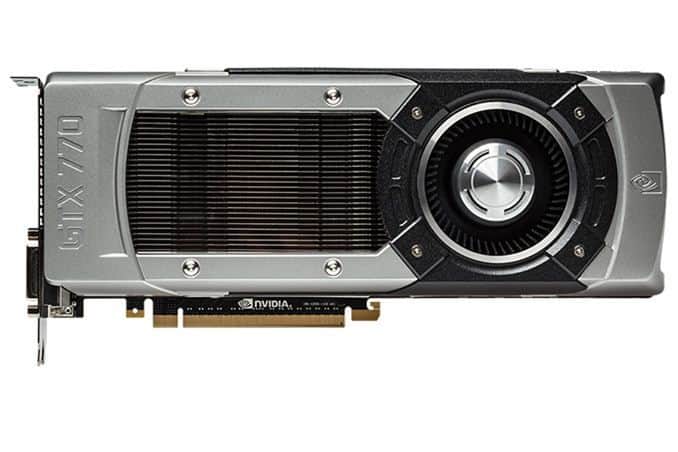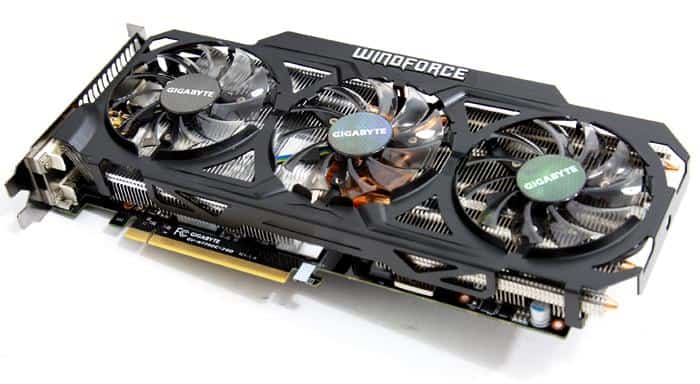amazon GeForce GTX 770 reviews
The Geforce GTX 770 does not have a performance advantage over the Geforce GTX 680, but is equipped with more powerful graphics, clock and higher memory bandwidth, suitable for graphics processing and gaming. Test Lab evaluates Asus GTX 770-DC2OC-2GD5, Gigabyte GV-N770OC-2G and Zotac GTX 770 AMP! Edition.
Design
Three products from Asus, Gigabyte and Zotac are based on Nvidia’s GeForce GTX 770 GPU (codenamed Kepler GK104-425). All three graphics cards carry the company’s features, full size and occupy two expansion slots on the motherboard when assembled. So these cards are only suitable for mid-tower, upright or best-in-class full-tower multi-SLI graphics cards.
Note that all three graphics cards are overclocked by the manufacturer so will need two power lines + 12V PCIe 6 pins and 8 pins with a power of 300W and 600 watts or higher to ensure the work for the whole system.
Asus GTX 770-DC2OC-2GD5 (Asus GTX 770OC) graphics card manufacturers are overclocked manufacturers, so the GPU is clocked at 1,058MHz and 1.110MHz in Boost mode while keeping the RAM clock. DirectCU II technology with two 80mm cooling fans and three large brass heatpipes directly touches the GPU surface to increase heat dissipation, resulting in approximately 20% better cooling performance compared to normal radiators. The card is also equipped with a VGA Hotwire feature to make the overclocking process simpler and more secure when used with the Republic of Gamers (ROG) motherboards.
The Gigabyte GV-N770OC-2GD (Gigabyte GV-N770OC) is clocked at 1.137MHz by the manufacturer and can reach up to 1,189MHz when accelerated; Higher than the 8.7% and 9.6% respectively compared to the standard Nvidia announced and higher than the Asus GTX 770OC slightly. The 450W WindForce 3x 2-slot cooler with 6 heatpipes, including 2 8mm tubes and 6mm tubes plus 3 80mm “Triangle Cool” cooling fans, ensures optimum heat dissipation while overclocking. Gigabyte said the new design of this radiator is capable of handling heat output when the card capacity reaches 450W while the GeForce GTX 690 and Radeon HD 7990 multi-core graphics cards have the highest TDPs respectively 300W and 375W.
Other than the two graphics cards, Zotac GTX 770 AMP! The Edition (Zotac GTX 770 AMP) is not only GPU overclocked, but also boosts the memory clock to 1,800MHz. The card’s test results are higher in most performance evaluations and also consume more power. The Dual Silencer cooling system incorporates two 80mm cooling fans to ensure efficient heat dissipation as well as minimizing the noise generated during operation. According to Zotac, compared to conventional heat sinks, the Dual Silencer technology reduces the noise level by 10°C and 10 dB during operation.
where can you get a GeForce GTX 770 online
EVGA GeForce GTX770 SuperClocked with EVGA ACX Cooler, 2GB GDDR5 256bit, DL DVI-I, DVI-D, HDMI, DP, SLI Ready Graphics Cards (02G-P4-2774-KR): Buy it now
Nvidia GeForce GTX 770 2GB GDDR5 PCI Express 3.0 Graphics Card: Buy it now
EVGA GeForce GTX 770 Superclocked 2GB GDDR5 256bit, Dual-Link DVI-I, DVI-D, HDMI,DP, SLI Ready Graphics Card (02G-P4-3771-KR): Buy it now
EVGA GeForce GTX 770 Superclocked with ACX Cooler 4 GB GDDR5 256-Bit Dual-Link DVI-I/DVI-D HDMI DP SLI Ready Graphics Card 04G-P4-3774-KR: Buy it now
Performance
To evaluate the power of the three GTX 770 cards, Test Lab uses a test configuration built on the Gigabyte Z77X-UD3H motherboard platform, Intel Core i7-3770K processor, Windows 8 Pro 64 bit OS and drivers. Controller (GeForce 320.18 driver). In addition to the overall performance benchmarking tools 3DMark 11 and Heaven DX11 Benchmark 4.0, Test Lab also uses some DirectX 11 games such as DiRT 3, Alien Vs. Predator and Crysis 2 to test the graphics performance of the graphics card at 1280×720 pixel resolution (HD 720p) and 1920×1080 pixels (full HD 1080p).
Overall, test results show that three graphics cards are quietly passing Test Lab tests with “remarkable” scores at both 1920×1080 pixel resolution and graphics highest quality. The point to note is that all three graphics cards are GPU clocked and have different memory values and they directly affect the test results. However, in the same test, the scores achieved between the cards were not significantly different because they were based on the same GeForce GTX 770 model.
The GIGABYTE GV-N770OC is slightly better at 3DMark 11 with 10,466 points in Performance mode (1280×720 pixels resolution), while the Asus GTX 770OC delivers better results in Extreme mode (1920×1080 pixels) with 3,876 dots. The Zotac GTX 770 AMP has the advantage of the DX11 Heaven benchmark v4.0, which has many similarities with 3DMark 11, but highlights Tessellation – one of the highlights of the DirectX 11 graphics library.
Similar to the test games are DiRT 3, Alien Vs. Predator 1.03 and Crysis 2, all three graphics cards are good enough, the game’s processing power goes beyond 30 fps at full HD resolution with graphics quality pushed to the highest level. Specifically with Alien Vs. Predator, 3 graphics cards: Asus, Gigabyte and Zotac range from 66.1 to 66.5 fps. The “GeForce GTX 770” motor power continues to show in DiRT 3 when the test results of the three cards are higher than 100 fps. With Crytek’s Crysis 2 – a “monument” FPS genre, the test results of the card at full HD resolution, Extreme graphics quality is still more than double that of 30 fps, with the Zotac GTX 770. AMP reaches 54 fps and highest is Gigabyte GV-N770OC with 64.2 fps.
Temperature, power consumption
Testing the graphics card thermal clearance and power consumption of the test configuration (not including the monitor) through 3DMark 11 graphics tests, temperature and system power are recorded through the GPU-z software and Logger Lite in normal environment (about 29 – 30 degrees Celsius).
In no-load mode, the card’s performance was smooth, the GPU temperature was about 3 degrees Celsius. The lowest was the Zotac GTX 770 AMP at 37 degrees Celsius, the test configuration power was 104.9 W respectively. The Gigabyte GV-N770OC has the highest GPU temperature (40 degrees Celsius) but its power consumption is only 82.2 W, 26.5% lower than the Asus GTX 770OC (111.8 W).
With 3DMark 11 graphics tests, GPU temperatures range from 80 to 81 degrees Celsius, with negligible variations. The cooling system remains quiet, while the highest tested configuration capacity of the Zotac GTX 770 AMP is 348.3 W (the highest value). The only increase in GPU clock and RAM is the “advantage” of the Asus and Gigabyte graphics card when the power consumption is 331.9 and 327.5 W respectively, lower than the card Zotac card from 16.4 to 20.8 W.
Generally speaking, the GTX 770 graphics cards have not distinguished themselves from the performance of the GTX 680, but with a higher graphics core, clock speed and memory bandwidth about 16% higher than the GTX 680 New strength, better meet user needs.

